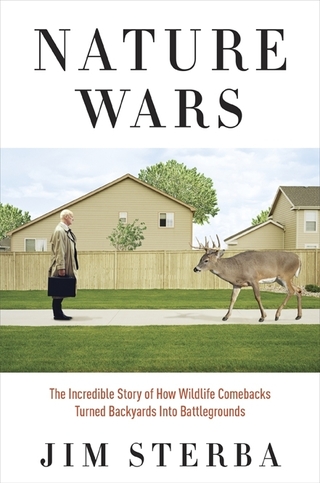Nature Wars: The Incredible Story of How Wildlife Comebacks Turned Backyards into Battlegrounds.
A LOS ANGELES TIMES BOOK PRIZE FINALIST
City of Santa Monica and Library
"His book, written with considerable charm and more wit than commonly found in works that deal with ecosystems, includes extensive and often entertaining treatments of such common nuisances as beavers, Canada geese, and feral cats, as well as various animal support lobbies that make life miserable and sometimes dangerous for wildlife control agents. For the denatured reader, there is a wealth of useful statistics."
-- Russell Baker, New York Review of Books, Feb. 21, 2013.
"If you love animals and trees and other wonders of the natural world, this book will astonish you. Sterba's great gifts are reportorial energy, out-of-the-box thinking, and an easy, relaxed prose style that makes Nature Wars a pleasure to read, even as its counterintuitive discoveries explode on every page."
--Daniel Okrent, author of Last Call: The Rise and Fall of Prohibition.
Synopsis:
For 400 years, European explorers, traders, and settlers plundered North American wildlife and forests in an escalating rampage that culminated in the late 19th century “era of extermination.” By 1900, upwards of thirty million deer had been reduced to less than 500,000, ten million wild turkeys were down to 30,000, many wild animal and bird populations were isolated remnants or threatened with extinction, and worry mounted that our country was running out of trees.
Then, in the 20th century, an incredible turnaround took place. Today, it is quite likely that more people live in closer proximity to more wild animals, birds and trees in America than anywhere on the planet at any time in history. This should be wonderful news -- unless, perhaps, you are one of 4,000 drivers who will hit a deer today, your child’s soccer field is carpeted with goose droppings, coyotes are killing your pets, the neighbor’s cat has turned your bird feeder into a fast-food outlet, wild turkeys have eaten your newly-planted seed corn, beavers have flooded your driveway, or bears are looting your garbage cans. Nature Wars tells the story of how a wildlife comeback miracle became such a mess.
Trees had already begun to reclaim abandoned farm land in the 19th century, the start of the largest reforestation in the Americas since the Mayan collapse. In the 20th century, conservationists outlawed commercial hunting, created wildlife refuges, transplanted isolated species to restored habitats, and slowly nursed many wild populations back to health. Then, after the Second World War, something happened that conservationists hadn’t foreseen: sprawl. People moved first into suburbs on urban edges, and then kept moving out across the landscape. By 2000, a majority of Americans lived neither in cities or country but in that vast in-between called sprawl, which attracted a surprising number of wild species, too. The result was a mix of people, trees, and wildlife that should have been a nature-lover’s dream come true. It was, and it wasn’t. Many people couldn’t cope.
The trouble was that baby boomers and their offspring had increasingly withdrawn from the natural world. They spent most of their time indoors, got anthropomorphized versions of wild nature from films and TV, and were encouraged to treat pets like children and wild animals like pets. They discarded their grandparents’ hard-won knowledge of the working landscape and forgot obligations of responsible stewardship. Their Earth Day instincts told them to save creatures and trees. But as wild species multiplied and trouble with them grew, they faced a new reality: too much of a good thing. Conflicts erupted over how to deal with it. People divided into species partisans, staged demonstrations, went to court, and raised and spent fortunes to save geese, beavers, cats, coyotes, bears, deer and other creatures from people who wanted to harm or kill them. A growing chorus of environmentalists and wildlife biologists, meanwhile, argued that ecosystems needed protection from some of the very creatures that species partisans sought to save, and that means responsibly managing local landscapes for all their inhabitants, including people.

Speaking at Florida Fish & Wildlife Commission, 2014
CHICAGO TRIBUNE
"Smart and provocative...Nature Wars is a counterintuitive take on a social problem, and the tone is knowing and smart, not sarcastic or snide." Elizabeth Taylor.
KIRKUS [STARRED REVIEW!]
The Incredible Story of How Wildlife Comebacks Turned Backyards into Battlegrounds
Author: Sterba, Jim
Journalist Sterba (Frankie's Place: A Love Story, 2003, etc.) employs humor and an eye for the absurd to document the sometimes bizarre conflicts that arise as a consequence of America's transformed relationship with nature.
As forest cover has grown back to more than two-thirds of its pre-colonial extent, wildlife recovery from the “so-called era of extermination in the last half of the nineteenth century” has accelerated. People who grew up with teddy bears and Disney's Bambi have different attitudes to furry, cuddly creatures than their grandparents did. Nowadays, someone can get death threats while trying to protect communities from resurgent populations of dangerous wild creatures like coyotes and bears, or even from the activities of feral cats. Sterba provides a summary history of the wilderness colonists found, the replacement of the great eastern forest with farmland and the market-driven extermination of wildlife through commercial hunting and trapping. He continues with cases studies of beaver, deer, bear and geese to show how, as land has reverted to forest, human communities have been polarized by the development of “problems” with each of these species and others. The author presents a repeating pattern: At first, returners are welcomed and encouraged with food, only to be rejected as the dangerous downside begins to emerge. Detailed accounts of efforts to outline solutions, and also of such often-overlooked consequences of this pattern as roadkill, supplement this deeply conflicted overall picture.
An eye-opening take on how romantic sentimentalism about nature can have destructive consequences. 08/01/2012
PUBLISHERS WEEKLY:
In his latest, journalist Sterba (Frankie’s Place: A Love Story) provocatively and persuasively argues that just at the moment when humankind has distanced itself irrevocably from nature, its behavior patterns have put people in conflict with a natural world that they don’t know how to deal with. Dividing his work into three parts (“Forest People,” “Wild Beasts,” and “The Denatured Life”), Sterba boldly argues against the prevailing touchy-feely view of nature. Replete with statistics and a historical understanding of the cycles of humankind’s interaction with nature, Sterba tells of forests being cleared and animals hunted to extinction (until the conservation movement stepped in to curtail the damage), and people, already disconnected from the land, sprawled out into new artificial living arrangements that allowed “nuisance” animals to thrive. The deer, beavers, and brown bears that appear in exurbanites’ backyards have dire consequences for the ecological balance and our daily existence. Sterba takes aim at those who protest hunting as a means of population control, movies that anthropomorphize animals into harmless creatures, and Americans who no longer understand nature. Though Sterba can be self-righteous, the book presents a valuable counternarrative to the mainstream view of nature-human interaction. (Nov.)
Reviewed on: 07/23/2012
MORE PRAISE
“If there is one lesson to be learned from Jim Sterba’s book, it is: Be careful what you wish for. Having decimated our planet’s natural state, we are blithely over-compensating, over –correcting and overturning the balance of nature yet again. Nature, as seen by most of us through a double glazed picture window revealing a manicured lawn….but what’s that moose being chased by a coyote being chased by a black bear, doing there? Read Nature Wars and weep. Or at least, stop and think.”
– Morley Safer, 60 Minutes.
“Most Americans now live not in cities but in regrown forests, among at least as many deer as when Columbus landed. Jim Sterba tells us how this came to be and why it isn’t all good. In graceful, clear-eyed prose, he explains why we need to relearn how to cut, cull and kill, to restore a more healthy balance to our environment.” Paul Steiger, Editor-in-Chief, ProPublica.
"Anything Jim Sterba writes is worth reading--and his latest, Nature Wars, is terrific. Sterba casts a reporter's sharp eye on a little noticed war unfolding under our noses, in our own backyards."
-Joseph L. Galloway, co-author of We Were Soldiers Once...and Young, and We Are Soldiers Still.
"Although few of us realize it, America is at a turning point where we must rethink our most fundamental ideas about nature, animals, and how we live. Fortunately we have a wise and witty guide in Jim Sterba, whose Nature Wars. is my favorite kind of read -- a book that affectionately recasts much of what we thought we knew about our nation's past and our relationship to the American wild, while at the same time revealing how intimately we ourselves are a part of nature, but in the most surprising and unexpected ways. In Sterba's hands, your everyday notions about the creatures around you -- whether pests, pets, or magnificent beasts -- will turn into entirely new ways of seeing the world." -Trevor Corson, author of The Secret Life of Lobsters and The Story of Sushi.
“At last someone’s grappling with the elephant in the room – or rather the deer, the coyote, the beaver, the bear. Sterba’s book may strike some as observational comedy but he’s deadly serious. Every word rings true. Nature is vengeful.”
– John Darnton, author of Almost a Family.
"In this book, Jim Sterba has given us a fascinating, powerful, and important lesson in why we should be careful when we mess with Mother Nature.”
– Winston Groom, author of Forrest Gump.
“Jim Sterba has done a brilliant job explaining how it happens that drivers more often than ever run into deer, wild turkeys gorge on newly-planted seed corn, and why golf courses are filled with people chasing geese down the fairways with 5 irons in hand. This informative and beautifully written book gives us the effect of civilization (often well-meaning) on the natural habitat, both flora and fauna.” – Peter Duchin, musician and author of Ghost of Chance.
Jim Sterba has been a foreign correspondent, war correspondent and national news reporter for more than three decades for The New York Times and The Wall Street Journal. He and his wife, the author Frances FitzGerald, live in New York City, and spend summers at Frankie's Place on Mount Desert Island in Maine.
